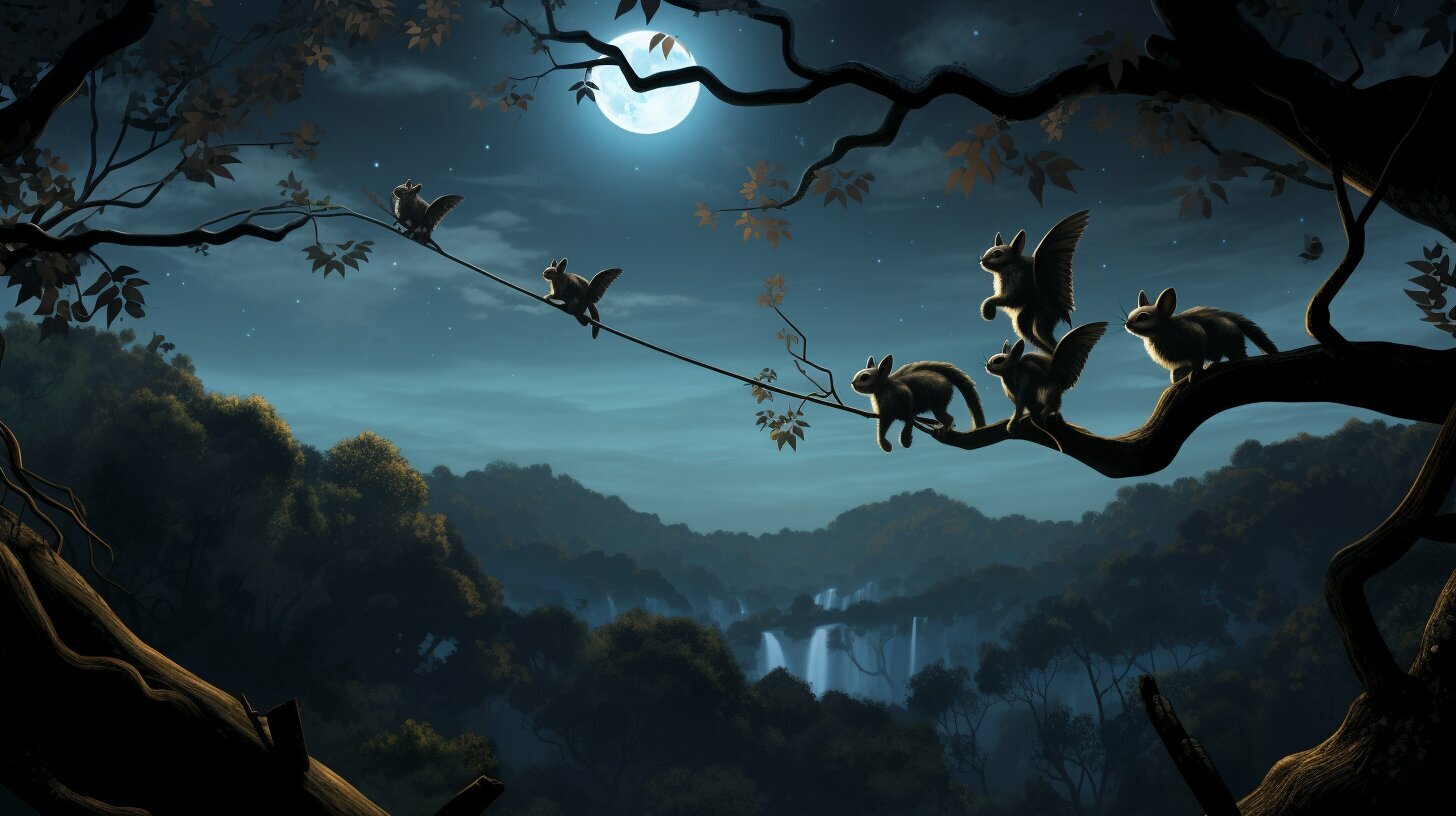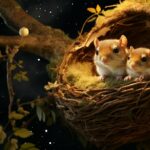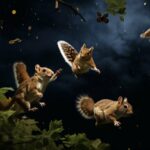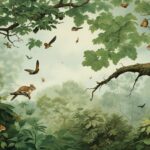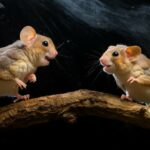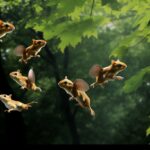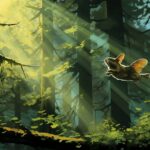Flying squirrel migration is a fascinating phenomenon that allows these arboreal creatures to embark on remarkable journeys. These unique rodents, known for their gliding abilities, navigate vast distances using a membrane of skin called a patagium. The New World flying squirrels, specifically Glaucomys sabrinus and Glaucomys volans, are closely associated with the northern coniferous and deciduous hardwood forests of North America.
Molecular studies have revealed distinct evolutionary lineages within these species, indicating potential gene flow between different populations. The Quaternary climatic fluctuations and changes in forest habitats have played a role in the evolutionary diversification and geographical isolation of flying squirrel populations.
However, flying squirrels face numerous threats, including illegal trapping and smuggling for the exotic pet trade. It is alarming to note that a significant smuggling enterprise has been discovered in Florida, highlighting the exploitation of legal captive-breeding operations. As a result, conservation efforts are necessary to protect flying squirrels and their forest habitats, as habitat destruction and hunting pose significant challenges to their survival.
Key Takeaways:
- Flying squirrels have a unique ability to glide through the air using a membrane of skin called a patagium.
- Glaucomys sabrinus and Glaucomys volans are the New World species closely associated with the northern coniferous and deciduous hardwood forests of North America, respectively.
- Molecular studies have revealed distinct evolutionary lineages within these species, suggesting potential gene flow between different populations.
- The Quaternary climatic fluctuations and changes in forest habitats have influenced the evolutionary diversification and geographical isolation of flying squirrel populations.
- Illegal trapping and smuggling for the exotic pet trade pose significant threats to flying squirrels and their populations.
The Gliding Wonders: Flying Squirrels and Their Unique Adaptations
Flying squirrels, known for their extraordinary gliding abilities, are remarkable creatures that have evolved unique adaptations to thrive in their arboreal habitats. These arboreal species, specifically the New World flying squirrels, Glaucomys sabrinus and Glaucomys volans, are closely associated with the northern coniferous and deciduous hardwood forest biomes of North America, respectively.
One of the most fascinating features of flying squirrels is their patagium, a membrane of skin that extends between their limbs and tail. This patagium allows them to glide through the air with effortless grace. It acts like a parachute, enabling them to navigate their forest environments by jumping from tree to tree over distances of up to 150 feet.
In addition to their gliding abilities, flying squirrels possess sharp claws and keen eyesight, which help them to navigate through the dense canopy and locate food sources. They have also developed special adaptations to ensure their survival in their chosen arboreal habitats. For example, the flying squirrel’s soft and dense fur provides excellent insulation, allowing them to withstand the harsh winter temperatures and retain body heat.
These amazing creatures have captivated researchers, leading to molecular studies that have revealed distinct evolutionary lineages within the New World flying squirrel species. These findings suggest that gene flow between different populations may occur, contributing to their genetic diversity. However, the Quaternary climatic fluctuations and changes in forest habitats have played a significant role in the evolutionary diversification and geographical isolation of flying squirrel populations, shaping their distribution patterns and characteristics.
| Evolutionary Lineages | Species | Forest Biome |
|---|---|---|
| Lineage 1 | Glaucomys sabrinus | Northern coniferous forests |
| Lineage 2 | Glaucomys volans | Deciduous hardwood forests |
Unfortunately, the beauty and uniqueness of flying squirrels have also made them targets for illegal trade. There have been instances of these animals being trapped and smuggled for the exotic pet market, the most notable case being a significant smuggling enterprise discovered in Florida. This illegal trade not only poses a threat to the flying squirrel populations but also highlights the exploitation of legal captive-breeding operations.
It is crucial to implement effective conservation efforts to protect flying squirrels and their forest habitats. Deforestation and habitat destruction pose significant challenges to their survival, as these mammals rely on specific tree species for food and shelter. By raising awareness about the value of these arboreal species and the importance of habitat preservation, we can ensure the long-term survival of these gliding wonders.
Exploring Flying Squirrel Migration Patterns
Flying squirrel migration follows intriguing patterns, with these nocturnal animals embarking on regular journeys in search of food and suitable habitat. These arboreal rodents, known for their gliding abilities, have captivated researchers and wildlife enthusiasts alike with their unique migratory behavior. Let’s delve deeper into the fascinating world of flying squirrel migration patterns.
Migration in flying squirrels is influenced by various factors, including seasonal changes, food availability, and the quality of their habitat. These agile gliders often cover impressive distances during their migrations, moving between different forested areas in search of resources.
Studies have revealed that flying squirrels undertake both short-distance and long-distance movements, with some individuals traveling over 100 kilometers. These migrations are not limited to specific geographical regions, as flying squirrels have been observed migrating across diverse habitats, including coniferous and deciduous forests.
During their journeys, flying squirrels rely on their acute sense of smell and memory to navigate through unfamiliar landscapes. They are also known to communicate with each other through vocalizations and scent marking, which helps maintain social connections and locate suitable habitat along their migratory routes. By understanding the intricacies of flying squirrel migration, we can gain valuable insights into animal behavior and the importance of conserving their forest habitats.
| Migratory Behaviors | Migrations observed in flying squirrels |
|---|---|
| Seasonal movements | Flying squirrels migrate during specific seasons to capitalize on food availability and breeding opportunities. |
| Long-distance migrations | Some individuals cover impressive distances, moving between different forested areas to find suitable resources. |
| Short-distance movements | Within their home ranges, flying squirrels undertake smaller migrations to locate nesting sites and explore new territories. |
- Flying squirrels rely on their sense of smell, memory, and social communication to navigate during their migrations.
- Migration patterns are influenced by factors such as seasonal changes, food availability, and habitat quality.
- The ability of flying squirrels to adapt to diverse habitats highlights their resilience and importance in forest ecosystems.
“Flying squirrel migration illuminates the remarkable ability of these nocturnal creatures to traverse vast distances and adapt to changing environments. Their journeys are a testament to their biological resilience and the intricate connections between animals and their habitats.” – Wildlife expert
The Role of Hibernation in Flying Squirrel Migration
Hibernation is a vital part of flying squirrel migration, as these resilient creatures utilize this period to conserve energy and survive the harsh winter months. During hibernation, flying squirrels lower their body temperature, heart rate, and metabolic rate, allowing them to enter a state of dormancy. This enables them to minimize energy expenditure while living off stored fat reserves.
One fascinating aspect of their hibernation behavior is communal nesting. Flying squirrels often share tree cavities or nests, huddling together for warmth and protection. This communal lifestyle not only helps them conserve heat but also enhances their chances of survival against predators.
Interestingly, the timing and duration of hibernation can vary among different populations of flying squirrels. Factors such as geographical location, climate, and food availability influence when they enter hibernation and for how long. For example, populations living in colder regions may start hibernation earlier and have longer hibernation periods compared to those in milder climates.
| Benefits of Hibernation for Flying Squirrels |
|---|
| Conserves energy by reducing metabolic rate and physical activity. |
| Allows survival during periods of food scarcity, such as winter. |
| Provides protection against harsh weather conditions and predators. |
| Facilitates communal nesting, promoting social interaction and warmth. |
Understanding the role of hibernation in flying squirrel migration is crucial for their conservation. It highlights the significance of preserving their habitat and ensuring the availability of suitable nesting sites for hibernation. By protecting their forest habitats and raising awareness about the importance of these arboreal species, we can contribute to the long-term survival of these gliding wonders.
The Impact of Climatic Fluctuations on Flying Squirrel Populations
The ever-changing climate and forest habitats have played a significant role in shaping the genetic diversity and distribution of flying squirrels over time. These arboreal rodents, known for their gliding abilities, have adapted to survive in various environmental conditions. Molecular studies have revealed distinct evolutionary lineages within different species of flying squirrels, indicating potential gene flow between different populations.
During the Quaternary period, climatic fluctuations and changes in forest habitats have influenced the evolutionary diversification and geographical isolation of flying squirrel populations. As temperatures and precipitation patterns shifted, forests expanded and contracted, creating opportunities for population fragmentation and speciation. These fluctuations have not only shaped the genetic makeup of flying squirrels but have also affected their distribution patterns.
Illegal trade poses a significant threat to flying squirrel populations and highlights the exploitation of these fascinating creatures. In recent years, a smuggling enterprise involving flying squirrels was uncovered in Florida, where they were being trapped and smuggled for the exotic pet trade. The illegal trade not only depletes wild populations but also undermines legal captive-breeding operations aimed at conserving these animals.
The Importance of Conservation Efforts
The conservation of flying squirrels and their forest habitats is crucial for their survival. As habitat destruction and hunting continue to pose significant challenges, it is imperative to protect and restore their natural environments. Flying squirrels play a vital role in forest ecosystems by dispersing seeds and contributing to the overall biodiversity of their habitats.
Conservation efforts should focus on raising awareness about the value of these arboreal species and the importance of their forest habitats. This can be achieved through educational campaigns, community involvement, and the establishment of protected areas. By preserving the unique adaptations and natural behaviors of flying squirrels, we can ensure their long-term survival and contribute to the overall conservation of our ecosystems.
| Key Points: |
|---|
| The genetic diversity and distribution of flying squirrels have been shaped by climatic fluctuations and changes in forest habitats. |
| Illegal trade poses a significant threat to flying squirrel populations, depleting wild populations and exploiting legal captive-breeding operations. |
| Conservation efforts are necessary to protect flying squirrels and their forest habitats and should focus on raising awareness and establishing protected areas. |
The Dark Side: Illegal Trade and Conservation Challenges
Sadly, flying squirrels face threats from illegal trapping and smuggling, posing a significant challenge to their populations and highlighting the need for conservation efforts. These adorable arboreal creatures, known for their gliding abilities and unique adaptations, have become targets of the exotic pet trade, fueling an illegal trade network that extends across borders.
The illegal trade of flying squirrels is a dark and lucrative business. Trappers capture these vulnerable animals from their natural habitats, often using cruel methods that cause immense suffering. Once captured, these squirrels are then smuggled across the country or even internationally, destined for the exotic pet market where their high demand fetches a hefty price.
This illegal trade not only disrupts natural ecosystems but also decimates the flying squirrel populations. The indiscriminate trapping and smuggling of these creatures can lead to overexploitation, taking a toll on their numbers. Moreover, the illegal trade often involves the exploitation of legal captive-breeding operations, posing a serious threat to the integrity of these breeding programs.
To safeguard the future of flying squirrels and protect them from the clutches of the illegal trade, comprehensive conservation efforts are essential. Conservation organizations are working tirelessly to raise awareness about the plight of these remarkable creatures, advocating for stronger legislation and stricter enforcement against wildlife trafficking. Additionally, protecting their forest habitats from deforestation and ensuring sustainable management practices are key to preserving the homes of these unique arboreal species.
| Challenges | Solutions |
|---|---|
| Habitat destruction | Implement sustainable forestry practices |
| Illegal trapping and smuggling | Strengthen legislation and enforcement |
| Lack of awareness | Educate the public about the importance of conservation |
Protecting Flying Squirrels and Their Forest Habitats
To ensure the survival of flying squirrels, it is crucial to prioritize conservation efforts that safeguard their forest habitats and address the threats they face. These remarkable arboreal rodents rely heavily on intact forest ecosystems for their survival, as they provide the necessary resources for nesting, foraging, and gliding.
One effective way to protect flying squirrels and their habitats is through the establishment of protected areas and nature reserves. These designated areas serve as sanctuaries where these creatures can thrive undisturbed, allowing their populations to flourish. Furthermore, implementing sustainable forestry practices that promote habitat preservation and minimize habitat fragmentation is essential.
Education and awareness also play a significant role in protecting flying squirrels and their forest habitats. By disseminating information about the importance of these animals to the ecosystem and highlighting the threats they face, we can mobilize public support for conservation efforts. Local communities, wildlife enthusiasts, and nature organizations can collaborate to organize workshops, nature walks, and awareness campaigns to engage individuals and foster a sense of responsibility for the preservation of these unique creatures.
| Threats to Flying Squirrels and Their Habitats | Conservation Actions |
|---|---|
| Habitat Destruction | – Establish protected areas and nature reserves – Promote sustainable forestry practices |
| Illegal Trade | – Strengthen law enforcement against wildlife trafficking – Raise awareness about the consequences of supporting the exotic pet trade |
| Hunting | – Enforce hunting regulations and prohibit the hunting of flying squirrels – Engage local communities in sustainable wildlife management practices |
“Flying squirrels are valuable indicators of forest health and biodiversity. By protecting them and their forest habitats, we are safeguarding an entire ecosystem and ensuring a sustainable future for these incredible creatures.”
The Importance of Collaborative Conservation
Conservation efforts aimed at protecting flying squirrels and their forest habitats require collaboration among various stakeholders. Government agencies, non-profit organizations, researchers, and local communities must work together to develop comprehensive conservation plans and implement effective strategies. Monitoring and research programs can provide valuable insights into the behavior, population dynamics, and habitat requirements of flying squirrels, enabling informed decision-making and targeted conservation actions.
By fostering partnerships and encouraging the involvement of the public in citizen science initiatives, we can create a collective force for change. Together, we can ensure that flying squirrels continue to grace our forests, captivating us with their extraordinary gliding abilities and serving as indicators of a thriving, biodiverse ecosystem.
Conclusion
In conclusion, the intricate world of flying squirrel migration offers us a glimpse into the wonders of animal behavior and reminds us of the urgent need to protect these incredible creatures and their natural habitats. Flying squirrels, with their unique gliding abilities and specialized adaptations, have captivated researchers and nature enthusiasts alike.
Through their seasonal movements and migration patterns, flying squirrels navigate vast distances, influenced by factors such as food availability, temperature, and breeding requirements. Hibernation plays a crucial role in their migration behavior, allowing them to conserve energy during harsh winter conditions.
However, flying squirrel populations face numerous challenges, including the detrimental effects of climatic fluctuations and habitat destruction. The Quaternary period, characterized by significant climate changes, has shaped the evolutionary diversification and geographical isolation of these remarkable rodents.
Additionally, the illegal trade of flying squirrels poses a serious threat to their survival. Exploitation of legal captive-breeding operations and smuggling for the exotic pet market have been documented, highlighting the need for strict conservation measures and increased awareness about the importance of preserving these arboreal species and their forest habitats.
The Importance of Conservation
Protecting flying squirrels and their forest habitats is crucial for maintaining the delicate balance of ecosystems. Preserving their natural habitats not only safeguards the well-being of these charismatic creatures, but also contributes to the overall biodiversity and ecological stability of the regions they inhabit.
Nature conservation efforts should focus on habitat protection, reforestation initiatives, and enforcing strict regulations against illegal wildlife trade. Education and awareness campaigns can help foster a deeper understanding and appreciation for flying squirrels, inspiring individuals and communities to take active steps in conservation.
By working together to protect flying squirrels and their forest habitats, we can ensure the continued existence of these remarkable gliding wonders and preserve the natural beauty and biodiversity of our planet for future generations to enjoy.
Do Flying Squirrels Build Nests During Migration?
Recent research on flying squirrel nesting habits discovered that these fascinating creatures do not build nests during migration. Instead, they rely on natural tree cavities or abandoned bird nests for shelter. This behavior not only saves time and energy during their long journeys but also allows them to quickly adapt to different environments. Fascinating insights into the lives of these agile gliders continue to amaze researchers worldwide.
FAQ
Q: What are flying squirrels?
A: Flying squirrels are arboreal rodents known for their gliding abilities. They have a membrane of skin called a patagium that allows them to glide through the air.
Q: What species of flying squirrels are associated with different forest biomes in North America?
A: New World flying squirrels, specifically the species Glaucomys sabrinus and Glaucomys volans, are closely associated with the northern coniferous and deciduous hardwood forest biomes of North America, respectively.
Q: Are there distinct evolutionary lineages within Glaucomys sabrinus and Glaucomys volans?
A: Yes, molecular studies have revealed distinct evolutionary lineages within G. sabrinus and G. volans, indicating potential gene flow between different populations.
Q: How have Quaternary climatic fluctuations and changes in forest habitats influenced flying squirrel populations?
A: Quaternary climatic fluctuations and changes in forest habitats have played a role in the evolutionary diversification and geographical isolation of flying squirrel populations.
Q: Is the illegal trade of flying squirrels a problem?
A: Yes, flying squirrels can be illegally trapped and smuggled for the exotic pet trade. There have been significant smuggling operations discovered, including one in Florida.
Q: Why is the illegal trade of flying squirrels a threat to their populations?
A: The illegal trade of flying squirrels poses a threat to their populations as it highlights the exploitation of legal captive-breeding operations and contributes to the decline of their numbers.
Q: What challenges do flying squirrels face in terms of conservation?
A: Flying squirrels face challenges in terms of habitat destruction and hunting, which pose significant threats to their survival. Conservation efforts are necessary to protect both flying squirrels and their forest habitats.
Q: Why is it important to protect flying squirrels and their forest habitats?
A: It is important to protect flying squirrels and their forest habitats because they are valuable arboreal species. Their conservation helps maintain biodiversity and the health of forest ecosystems.

